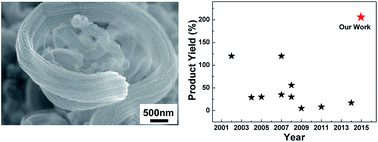Large-scale synthesis and characterization of super-bundle single-walled carbon nanotubes by water-assisted chemical vapor deposition
Abstract
A large-scale synthesis of water-assisted single-walled carbon nanotubes (SWCNTs) was investigated over Fe–Mo/MgO catalysts by catalytic chemical vapor deposition of ethylene. Introduction of water vapor into a reactor induced super-bundle SWCNTs (SB-SWCNTs) and dramatically improved the product yield of SWCNTs from 40 to 206 wt%. By adding water vapor, the average diameter of the SB-SWCNTs was increased from 1.5 to 3.0 nm and distribution of the diameter became wider. The Raman peak intensity ratio (IG/ID) of the SWCNTs, which indicates the crystallinity and defect degree of SWCNTs, showed an almost constant value of 8 regardless of water vapor concentration. The possible growth mechanism of SB-SWCNTs was discussed.


 Please wait while we load your content...
Please wait while we load your content...